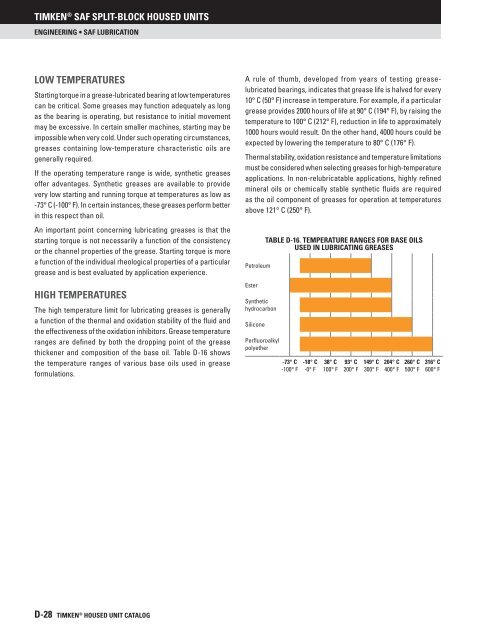You also want an ePaper? Increase the reach of your titles
YUMPU automatically turns print PDFs into web optimized ePapers that Google loves.
<strong>Timken</strong> ® SAF SPLIT-BLOCK HOUSED UNITS<br />
Engineering • SAF Lubrication<br />
Low temperatures<br />
Starting torque in a grease-lubricated bearing at low temperatures<br />
can be critical. Some greases may function adequately as long<br />
as the bearing is operating, but resistance to initial movement<br />
may be excessive. In certain smaller machines, starting may be<br />
impossible when very cold. Under such operating circumstances,<br />
greases containing low-temperature characteristic oils are<br />
generally required.<br />
If the operating temperature range is wide, synthetic greases<br />
offer advantages. Synthetic greases are available to provide<br />
very low starting and running torque at temperatures as low as<br />
-73° C (-100° F). In certain instances, these greases perform better<br />
in this respect than oil.<br />
An important point concerning lubricating greases is that the<br />
starting torque is not necessarily a function of the consistency<br />
or the channel properties of the grease. Starting torque is more<br />
a function of the individual rheological properties of a particular<br />
grease and is best evaluated by application experience.<br />
High temperatures<br />
The high temperature limit for lubricating greases is generally<br />
a function of the thermal and oxidation stability of the fluid and<br />
the effectiveness of the oxidation inhibitors. Grease temperature<br />
ranges are defined by both the dropping point of the grease<br />
thickener and composition of the base oil. Table D-16 shows<br />
the temperature ranges of various base oils used in grease<br />
formulations.<br />
A rule of thumb, developed from years of testing greaselubricated<br />
bearings, indicates that grease life is halved for every<br />
10° C (50° F) increase in temperature. For example, if a particular<br />
grease provides 2000 hours of life at 90° C (194° F), by raising the<br />
temperature to 100° C (212° F), reduction in life to approximately<br />
1000 hours would result. On the other hand, 4000 hours could be<br />
expected by lowering the temperature to 80° C (176° F).<br />
Thermal stability, oxidation resistance and temperature limitations<br />
must be considered when selecting greases for high-temperature<br />
applications. In non-relubricatable applications, highly refined<br />
mineral oils or chemically stable synthetic fluids are required<br />
as the oil component of greases for operation at temperatures<br />
above 121° C (250° F).<br />
Petroleum<br />
Ester<br />
Synthetic<br />
hydrocarbon<br />
Silicone<br />
Perfluoroalkyl<br />
polyether<br />
TABLE D-16. Temperature ranges for base oils<br />
used in lubricating greases<br />
-73° C<br />
-100° F<br />
-18° C<br />
-0° F<br />
38° C<br />
100° F<br />
93° C<br />
200° F<br />
149° C<br />
300° F<br />
204° C<br />
400° F<br />
260° C<br />
500° F<br />
316° C<br />
600° F<br />
D-28 TIMKEN ® HOUSED UNIT CATALOG

















